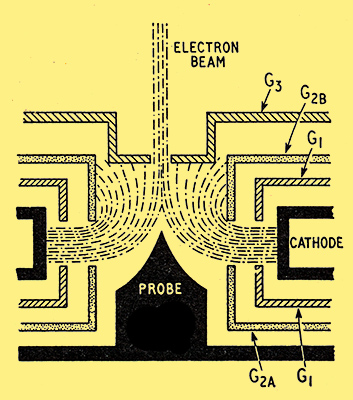|

Annular Electron Gun for television CRT's, devised at RCA Laboratories in America, offers the advantages of high modulation sensitivity and a small spot size which (with the focusing conditions) is largely independent of the beam intensity. In addition the gun provides internal video signal amplification and an automatic inversion of white-spot interference pulses. As shown in the sketch, the construction is based on an annular cathode, annular control grids (G1) and accelerating grids (G2A and G2B), an annular grid G3 which forms an object electrode, and a beam-bending probe. The control grid annuli are normally operated at the same potential (negative with respect to the cathode), while G2A and G2B are at different positive potentials (around 200 V) and the probe is at about -15 V.
In a conventional CRT the electron-optical object is the electron-beam cross-over point, but here the object is the uniformly illuminated aperture in G3, which is operated at about +50 V. This 0.007 in diameter hole gives a spot of nearly uniform intensity and with sharply defined edges. On the grid control characteristic of a 16 inch tube using the gun, an increase of negative control grid voltage first of all produces an increase of beam current and then the expected tail-off to zero, with maximum current occurring at about -15 V.
If the tube is modulated in a positive direction on the rising current section of the characteristic, only about 6 Volts of driving signal are required for full beam modulation. Any increase of signal over full modulation (whiter than white) produces a reduction in beam current and so provides the automatic interference inversion. Video signal amplification is obtained by inserting a load resistor in the positive supply to G2B. The amplified signal obtained across this could be re-applied to G3 or the probe to obtain a possible increase in modulation sensitivity or used for other purposes. Full details of the electron gun are given by J W Schwartz in the 1958 IRE National Convention Record, Part 3.
|